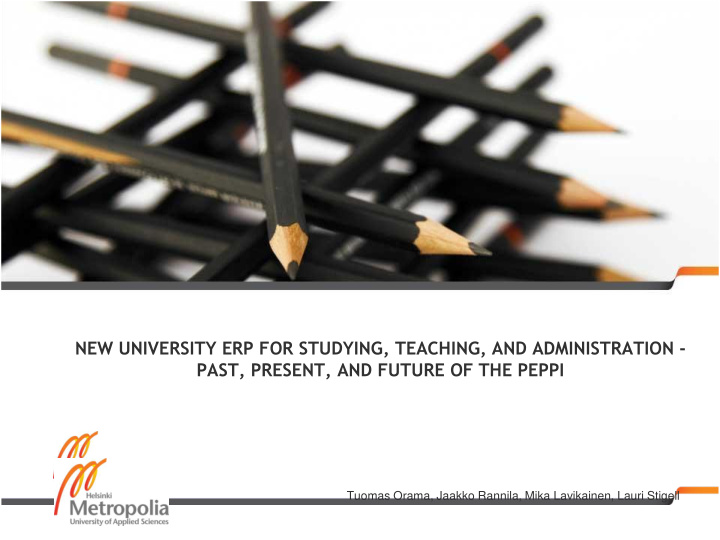



NEW UNIVERSITY ERP FOR STUDYING, TEACHING, AND ADMINISTRATION - PAST, PRESENT, AND FUTURE OF THE PEPPI Tuomas Orama, Jaakko Rannila, Mika Lavikainen, Lauri Stigell
Main education processes in Finland Teaching and planning processes Student administration processes Student processes
Introduction to history ● 20 year old student information systems (SIS) in use at the moment. ● National project called ProAMK started in 2005. The goal was to create new SIS for the whole sector. ● Another national project called RAKETTI started in 2009. The goal was to create new SIS for the whole sector.
The outcome ▪ In 2010 two major Universities of Applied Sciences started a project called Peppi. The goal was to create new Enterprise resource planning (ERP) system for education sector and Student information system (SIS). ▪ Using only their own money at their own risk
The goals of the project ▪ Create an ecosystem of services created in Service oriented architecture (SOA) fashion. ▪ Replace old systems with new services. ▪ Renew the Enterprise Architecture (EA) on it’s all levels: ▪ Business ▪ Information ▪ System ▪ Technology ▪ Create an ecosystem of services so that other HEI’s could start using Peppi-ecosystem ▪ Create new user interfaces in modern fashion
The environment - Finnish HEI environment ▪ Finnish HEI environment consists of universities and universities of applied sciences ▪ At the moment there are 14 universities and 24 universities of applied sciences but it is expected that there will be mergers in coming years. ▪ The other trend within the HEI environment is decreasing funding. The HEI’s are almost entirely government funded, and due to ongoing weak economic growth, the cuts have been considerable, even 15 %.
The environment - Establishment of the project Background investigations on national level: what, why, when, who - and who is paying? ▪ Lot’s of paper - No concrete results Highly useful background information for our projects ▪ Limited amount of organizations involved - easier to reach understandable specifications ▪ Part-time participation - part-time commitment ▪ You have to start in order to get results Our way: ▪ Develop the system for limited amount of organisations (in our case 2 biggest Universities of applied sciences in Finland) ▪ Publish the system as is for other HEI’s and continue development through consortium
Technical Financial constraints environment The Finnish public sector’s system architecture has been Financial resources only from the owner institutions focusing on these principles during the last decade: ▪ Interoperability - service interfaces Decisionmaking in the project without a need to ▪ Enterprise Architecture negotiate ▪ National Enterprise Service Bus ▪ Mobile services ▪ Open data The amount of money did not allow us to waste time: the high quality results were urgently needed in a ▪ Open source software limited time We wanted to have an answer to every principle mentioned above.
The results - new services for the Ecosystem Student information system ▪ Student registry ▪ Assessment / Accomplishment registry ▪ Code management ▪ Reports (eg. printed certificates and statistical reports) Student dashboard ▪ Personal curriculum management ▪ Personal assessments / accomplishments ▪ Personal reports ▪ Enrollments (Courses / Semesters) ▪ Personal information management Integrated dashboards ▪ Intranet ▪ Course workspaces ▪ Dashboard integrations
Desktops and Services Shared desktop services: Navigation menu, Search, Messages, User Information, Language settings Student’s Teacher’s Planner’s Manager’s Administrator’ Study Common Desktop Desktop Desktop Desktop administration Desktop s Desktop desktop •Communication •Transcript of •Resource •Resource •Applicant • Planning and • Desktops and •Quality records Planning Planning procedure Services monitoring •Calendar •Recognition of •Recognition of •Student • Information of Management activities •Personal prior Learning prior Learning management Resources •Workspaces • Project •Reporting •Reporting •Graduates/Diplo • Curriculum Rules Curriculum •Materials portfolios •Progress •Curriculum •Curriculum • Settings for mas management •People • Reports •Reports monitoring management planning Organisation level •Tools •Agreement •Implementations •Year planning •Calendar •Study Materials •Units Archive •Recognition of •Maintenance prior Learning •Certificates Common Services: Communication and Quality Management Service Bus Information resources
Dashboards and the user interfaces
Student accomplishments
Student semester enrollments
Group progress
Personal curriculum
The state of the development ▪ Peppi-ecosystem covers all of the HE process areas excluding the student admission and alumni services ▪ Constant evaluation of future development needs
Peppi ecosystem coverage now The future ▪ Peppi Consortium ▪ Coverage today over 56% of Finnish HEI’s and still growing ▪ 14 universities of applied sciences ▪ 5 universities ▪ 2 vocational schools ▪ 10 company members ▪ Growing demand on Peppi services on upper secondary education ▪ Co-operation on national level - our development model is open ▪ Co-operation on international level is what we are looking for Peppi ecosystem coverage in the future
The future Peppi Ecosystem ▪ New services are being developed based on the needs of consortium members ▪ Integrations to cloud services (Drive, O365, Moodle, Optima etc.) ▪ Integrations to national application system (studyinfo.fi) ▪ New planning and optimization tools for scheduling ▪ Improvement of existing Ecosystem services ▪ Add- on services on top of API’s
Summary ▪ Past: ▪ Urgent need to renew old systems ▪ Useful national architecture definitions and networks ▪ Present: ▪ Project by project Peppi has covered the HE process and service needs ▪ Strong growing phase ▪ Future: ▪ Development continues ▪ Cooperation on many levels ▪ Continuous evaluation of our development and administrative model
Book you should read! ▪ Wise approach to create SOA
Thank you! Tuomas Orama & Jaakko Rannila
Recommend
More recommend